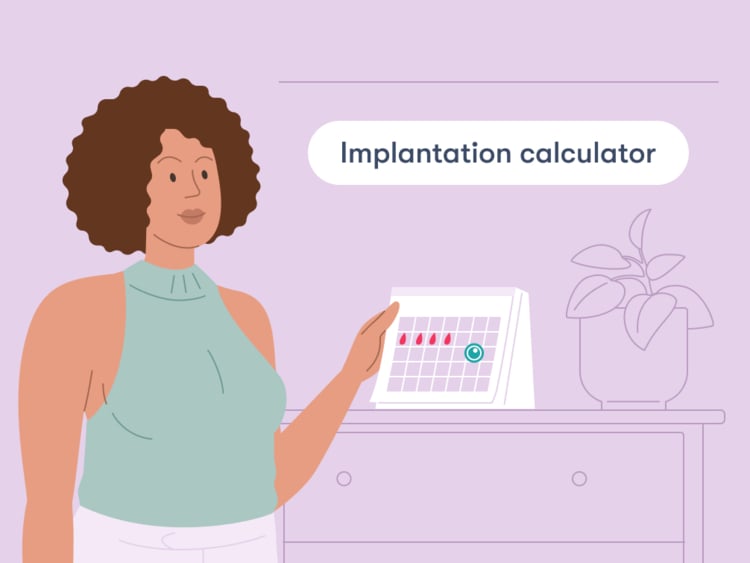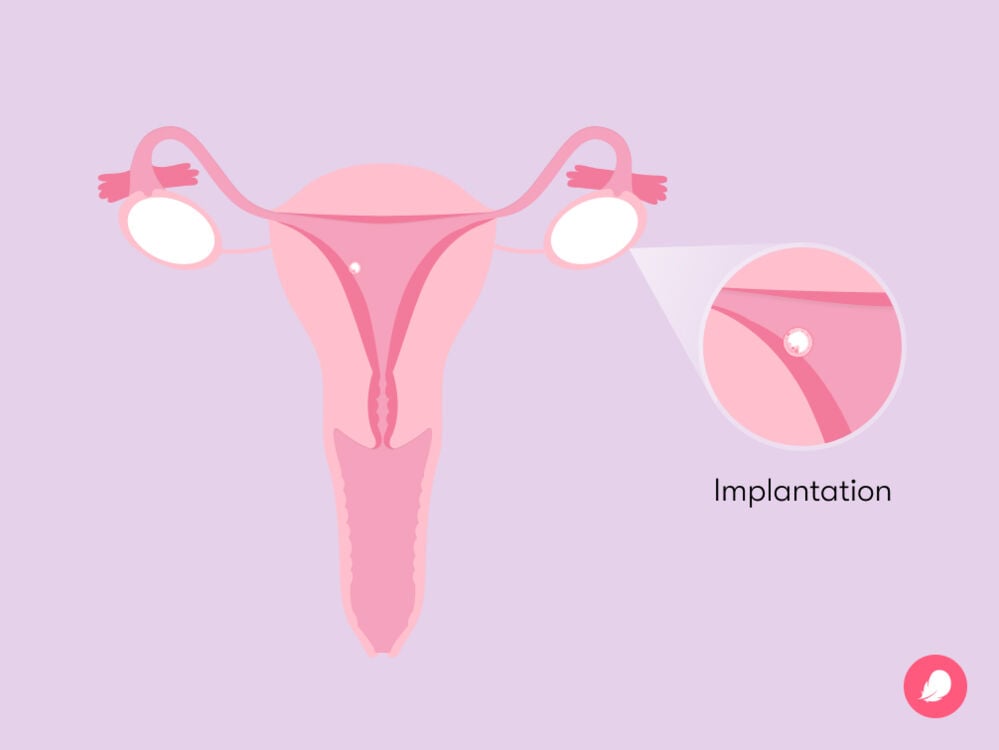-
Tracking cycle
-
Getting pregnant
-
Pregnancy
-
Help Center
-
Flo for Partners
-
Anonymous Mode
-
Flo app reviews
-
Flo Premium New
-
Secret Chats New
-
Symptom Checker New
-
Your cycle
-
Health 360°
-
Getting pregnant
-
Pregnancy
-
Being a mom
-
LGBTQ+
-
Quizzes
-
Ovulation calculator
-
hCG calculator
-
Pregnancy test calculator
-
Menstrual cycle calculator
-
Period calculator
-
Implantation calculator
-
Pregnancy weeks to months calculator
-
Pregnancy due date calculator
-
IVF and FET due date calculator
-
Due date calculator by ultrasound
-
Medical Affairs
-
Science & Research
-
Pass It On Project New
-
Privacy Portal
-
Press Center
-
Flo Accuracy
-
Careers
-
Contact Us
Implantation calculator: When does implantation happen?
Understanding what implantation is and when it might have happened can help you plan when to take a pregnancy test. Get the lowdown with Flo’s easy-to-use implantation calculator.



Your Flo membership is now active
To start your journey:- 1. Download the Flo app.
- 2. Log in to your account.
- Remember that implantation prediction tools can help you learn more about when you may have conceived, helping you plan when to take a pregnancy test for a more accurate result. This calculator is for informational purposes only and cannot confirm pregnancy. The calculations are estimates and based on your last self-reported day of ovulation or menstruation. For the most accurate pregnancy test result, it is best to wait until the day your period is due. Please note that menstrual periods are different from person to person and can vary from month to month.
- Please note that Flo Health does not collect, process, or store any of the data that you enter while using these tools. All calculations are done exclusively in your browser. Flo Health does not have access to the results. All data will be permanently erased after leaving or closing the page.

Implantation is the medical term used to describe when your fertilized egg attaches to your uterine lining. This is the point when you’re technically classed as being pregnant.
Getting a sense of when implantation might have happened can make it easier to plan the best time for a pregnancy test if you’re trying for a baby. However, you might not notice any signs or symptoms that it’s happened. Most people don’t.
You can use Flo’s implantation calculator to help you manage this. All you’ll need is the date of the first day of your last period or the date you might have ovulated. Getting pregnant really can feel like a numbers game.
Keep reading to find out how this implantation calculator works, plus everything else you need to know about implantation. And know that you can also use the Flo app to better understand your fertile window, ovulation, and when you can take a pregnancy test.
Key takeaways about calculating implantation
- Implantation describes when your fertilized egg attaches to your uterine lining. It usually occurs between six and 10 days after ovulation.
- Knowing your implantation date can help you determine when to take a pregnancy test to get the most accurate results.
- Implantation calculators like this one provide an estimated window for when implantation might have happened. It’s impossible to give you an exact date and time.
- You’ll need to know the date of the first day of your last period or when you might have last ovulated. An ovulation-tracking app like Flo can help you keep tabs on that.
How do I use an implantation calculator?
Flo’s implantation calculator estimates when implantation might have happened based on your menstrual cycle. All you need to do is enter your ovulation date or last menstrual period (LMP) date (if you know them), and the calculator will provide an estimated window of when implantation might have happened.
It’s important to remember that implantation calculators, like this one, can only offer a general window for implantation rather than a precise date. That’s because implantation timing can vary depending on when you ovulate and your individual menstrual cycle.
How do I understand implantation calculator results?
An implantation calculator like this one provides an estimated window for when implantation might happen based on the data you give it (when you started your last period or when you ovulated).
This timeframe is based on the average number of days it takes for a fertilized egg to travel to the uterus and implant. But this estimate can vary depending on your unique cycle and when fertilization actually took place. So, while it can be a useful guide, it isn’t set in stone.
How is your implantation window calculated?
Flo’s implantation calculator uses the date when you last ovulated to figure out your implantation window. If you aren’t sure when you last ovulated, you can still use the calculator by entering the date of the first day of your last period.
If you know the day you ovulated
You may already track your cycle using an app like Flo and know the day that you ovulated. If this is the case, then all you need to do is input the day that you ovulated and add six to 10 days to find out when your egg may have implanted.
Here’s what we mean: If you know you ovulated on day 18 of your cycle, then you’d figure out your implantation date by inputting:
18 + (6 to 10 days) = potential implantation on days 24 to 28 of your cycle.
It’s impossible to pinpoint the exact day that implantation may have occurred. However, you can use your implantation window as a guide.
If you don’t know the day you ovulated
If you’re unsure when you ovulated, don’t worry! You can enter the date of your last period. And if you’d like to find out when ovulation might happen for you, you can use an ovulation calculator or track your cycle with an app like Flo.
Take a quiz
Find out what you can do with our Health Assistant
How do you know if implantation was successful?
To better understand implantation, it can be helpful to understand what’s happening in your body when you become pregnant.
The average menstrual cycle is considered to be around 28 days. All cycles are different, and the length of yours may vary slightly from month to month, which means the day that you ovulate might change too. If your cycle is 28 days, then you’ll ovulate around day 14, but you can learn more about this using an app like Flo.
After one of your ovaries has released an egg, it remains viable for up to 24 hours. This means there’s a 24-hour period for it to meet and be fertilized by a sperm. If that happens, it’ll travel down one of your fallopian tubes and implant into the wall of your uterus. This is implantation and can occur between six and 10 days after ovulation.
Some people say they knew the day they got pregnant based on symptoms or signs they noticed around the days that implantation may have happened. These include:
- Implantation bleeding: This is light spotting or bleeding around two weeks after conception. This may come around the time of your period, but it will be lighter. You might mistake implantation bleeding for your period.
- Cramping: Some people report feeling minor cramps during implantation.
While it can be fun to guess when you conceived, the only way to know if implantation was successful is by taking a pregnancy test. The best time to do this is after a late or missed period.

How soon can you test for pregnancy after implantation?
For the most accurate result, try to wait until after a late or missed period before taking a pregnancy test. Flo’s pregnancy test calculator can help you find an even more precise testing window.
Home pregnancy tests work by detecting a pregnancy hormone called human chorionic gonadotropin (hCG) in your urine. Right after implantation, your hCG levels start rising, but it takes a little time to reach a level high enough for tests to pick up. HCG peaks at around 10 weeks.
Research shows that tests taken on the first day of a missed period are about 90% accurate. Waiting a week boosts accuracy to around 97%. Similarly, if your cycles are longer or you think you may have ovulated later in your cycle, then it’s important that you wait a little longer to take a test. Your best bet for a reliable result is to test on the day of your missed period or a few days after.
Frequently asked questions about implantation calculators
What is implantation, and when does it happen?
Implantation is the term used to explain when a fertilized egg attaches to your uterine lining. On average, implantation happens around six to 10 days after you’ve ovulated.
Once your ovaries release an egg during ovulation, it remains viable for up to 24 hours. If it’s fertilized by a sperm during this time, the egg travels down one of your fallopian tubes and may implant in your uterine wall.
References
“Fertilization and Implantation.” Mayo Clinic, www.mayoclinic.org/healthy-lifestyle/pregnancy-week-by-week/multimedia/fertilization-and-implantation/img-20008656. Accessed 24 Jan. 2025.
“Human Chorionic Gonadotropin.” Cleveland Clinic, my.clevelandclinic.org/health/articles/22489-human-chorionic-gonadotropin. Accessed 24 Jan. 2025.
“Implantation Bleeding.” Cleveland Clinic, my.clevelandclinic.org/health/symptoms/24536-implantation-bleeding. Accessed 24 Jan. 2025.
“Menstrual Cycle.” Cleveland Clinic, my.clevelandclinic.org/health/articles/10132-menstrual-cycle. Accessed 24 Jan. 2025.
“Ovulation.” Cleveland Clinic, my.clevelandclinic.org/health/articles/23439-ovulation. Accessed 24 Jan. 2025.
“Pregnancy Tests.” Cleveland Clinic, my.clevelandclinic.org/health/diagnostics/9703-pregnancy-tests. Accessed 24 Jan. 2025.
Wilcox, Allen J., et al. “Natural Limits of Pregnancy Testing in Relation to the Expected Menstrual Period.” JAMA, vol. 286, no. 14, 10 Oct. 2001, pp. 1759–61, doi:10.1001/jama.286.14.1759.


